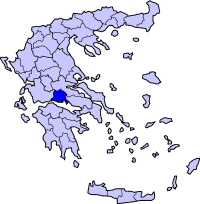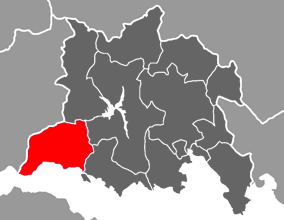.
Administrative Region : Central Greece
Regional unit : Fokida


Kastraki (Greek: Καστράκι, before 1927: Ομέρ Εφένδη - Omer Efendi[1]) is a village in Phocis, Greece, part of the municipal unit Efpalio. It is situated near the left bank of the river Mornos, and 3 km from the Gulf of Corinth. It is 3 km (2 mi) west of the village Efpalio and 6 km (4 mi) northeast of the town of Nafpaktos.
History
Kastraki is situated near the site of the ancient town of Oineon in Ozolian Locris of ancient Greece. Oineon was famous for the temple of Nemean Zeus and the site of Hesiod's death.[2] Hesiod was the second most ancient Greek poet after Homer and he lived Between 750 BC and 700 BC. He was born in Ascra of Boeotia and he is known as the father of the "didactic epic". He spent a good part of his life in Hesperia Locris that inspired him to write his epics. According to the story while he was a guest at the place of the Nafpaktian priest Ganyctora he insulted his daughter and her brothers Ktimenos and Antifos killed him in the temple of Nemean Zeus where he asked asylum. He was buried in all likelihood in Oineon or as others claim in Nafpaktos.
Although there is not absolute certainty, many believe that the temple of Nemean Zeus was located where the Orthodox church of Panagia Faneromene is today by the national road and the intersection of the Hiliadou provincial road. In fact, the temple was converted into a Christian church when people of the area accepted Christianity as their new religion. However, others think that the temple was located 3 km (2 mi)-4 km (2 mi) east, not west, of Efpalio in the village of New Koukoura where today the church of Analypsis is built.
In the history of ancient Greece Oineon is referred to in 426 BC when the Athenian General Demosthenes with 30 ships sailed to Locris and camped in Oineon. His plans were to bring under the Athenian authority Aitolea and eventually the all areas of, Locris and Phokis. In spite some early military success his gradual but continuous losses of his hoplites forced him to make a treaty with the Aeolians and retreated back at Oineon and Nafpaktos with the remnants of his army. While his remaining army sailed back to Athens Demosthenes fearing a punishment by the state of Athens for his failure remained in the vicinity of Nafpaktos.
During the 400 years of Turkish occupation the most fertile lands of Greece were given to prominent Turkish families or officials. As a result Greeks out of necessity were located in non prime agricultural lands mainly mountainous areas where they were not bothered as much by Turkish authorities. Phocis was not any different; Turks had taken from Greeks most fertile areas of Mornos plains as it is evidenced by the township names of Omer Efendi (Kastraki), Hasan–Aga (Agios Polykarpos), Sule (short of Suleiman) today’s Efpalio.
According to the 1827 writings "Trip around Greece" of French counselor to Ioannina Pouqueville, at the early 1800 there were 25 families living in Omar Effendi. Omar Effendi was part of the vilaeti (administration) of Lidoriki. The vilaeti of Lidoriki was under the Pasha of Nafpaktos for some time but also under the authority of the Albanian Ali Pasha (1750-1821) of Ioannina from Tepeleni also known as "Ali the Tepelenis".
Omar Effendi was the battle site several times over the 1821 Greek struggle for independence. The location of the village at the east side of the Mornos River on the road of Nafpaktos to Amfissa place it in a strategic position and a natural place to resist advancing troops between Aitolia and Phokis in either direction. In June 1822 a division of Omar Vryoni moved from Nafpaktos with destination Salona. However couple of kilometers east of Mornos River near Omar Effendi they met the troops of Triantafyllos Apokoritis and they were forced to retreat.
At the end of January 1826 near Omar Effendi, 5,000 the Greek forces of Skaltsodemos fought against the Turkish troops causing them many losses and preventing them from advancing east and forced them back to Nafpaktos. In December 1826 about 1500 Turks and Albanians rushing to Amfissa to assist to break the siege of Turkish troops in Amfissa by Greek freedom fighters never made it there. About two kilometers east of Mornos river near Omar Effendi they were surprised by the cavalry of Hatzimichales (under Karaiskakis leadership although he was not personally there) killing 53, capturing 22 and turning g the troops back to Nafpaktos.
The new and current name of the village Kastraki (little Castle) was given in 1927 when many Turkish given names to villages and towns were changed into Greek ones.[1] The name Kastraki was justified by the remnants of a Locric ancient castle at the borders of Locris and Aetolia about 3 kilometers south west of the village Trikorfo.
References
^ a b Name changes of settlements in Greece
^ Thucydides, 3.96.1.
Cox, George William (1876). A General History of Greece: From the Earliest Period to the Death of Alexander the Great, with a Sketch of the Subsequent History to the Present Time. Original from the New York Public Library: D. Appleton. p. 709 pages.
Woodhouse, William J. M.A F.R.G.S. (1897). Aetolia: Its Geography, Topography, and Antiquities. Clarendon Press.
Greece :
A - B - C - D - E - F - G - H - I - J - K - L - M -
N - O - P - Q - R - S - T - U - V - W - X - Y - Z
| Ancient Greece
Science, Technology , Medicine , Warfare, , Biographies , Life , Cities/Places/Maps , Arts , Literature , Philosophy ,Olympics, Mythology , History , Images Medieval Greece / Byzantine Empire Science, Technology, Arts, , Warfare , Literature, Biographies, Icons, History Modern Greece Cities, Islands, Regions, Fauna/Flora ,Biographies , History , Warfare, Science/Technology, Literature, Music , Arts , Film/Actors , Sport , Fashion --- |
Retrieved from "http://en.wikipedia.org/"
All text is available under the terms of the GNU Free Documentation License


